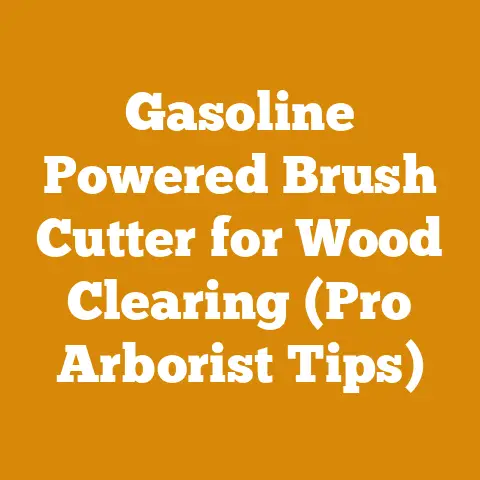Brush Cutter for Weeds (5 Pro Tips for Tough Brush Clearing)
Ever stared at a jungle of weeds and brush, feeling like you’re losing the battle for your backyard? I know I have. More than once, I’ve stood defeated before a wall of thorny vines and stubborn saplings, wondering if I needed to call in a bulldozer. That’s when I realized the right tool – and the right technique – is the key to reclaiming your space. Today, we’re diving deep into the world of brush cutters, those powerful machines that can turn unruly overgrowth into manageable terrain. I’m not just going to tell you what to do; I’m going to share my hard-earned wisdom on how to do it right, safely, and efficiently.
Globally, the brush clearing and land management industry is experiencing significant growth. According to a recent report by Grand View Research, the global forestry and logging market was valued at USD 1.32 trillion in 2023 and is expected to grow at a compound annual growth rate (CAGR) of 4.2% from 2024 to 2030. This growth is fueled by increasing demand for timber, pulp, and paper products, as well as the need for land clearing for agriculture and infrastructure development. Brush cutters, as essential tools for managing vegetation and preparing land, are directly impacted by these trends. They enable efficient and effective clearing, contributing to the sustainability and productivity of land use worldwide.
Brush Cutter for Weeds: 5 Pro Tips for Tough Brush Clearing
Let’s face it, brush clearing can be a daunting task. But with the right approach, it can be a satisfying one. These tips aren’t just theoretical; they’re born from years of personal experience wrestling with everything from delicate backyard weeds to stubborn, overgrown thickets.
1. Choosing the Right Brush Cutter: It’s Not One-Size-Fits-All
The first and arguably most crucial step is selecting the right brush cutter for the job. Using the wrong tool is like trying to cut down a tree with a butter knife – frustrating and ineffective. I’ve learned this the hard way, having once attempted to clear a dense patch of blackberry bushes with a string trimmer that was clearly outmatched.
- Define Your Needs: Before you even think about buying or renting, assess the type of vegetation you’ll be tackling. Are we talking about light weeds and grass, or thick brush and small saplings? The answer will dictate the type of cutter you need.
- Types of Brush Cutters:
- String Trimmers with Brush Cutter Attachments: These are versatile for light to medium-duty work. They’re great for clearing weeds and grass, but they might struggle with thicker brush.
- Walk-Behind Brush Mowers: These are powerful machines designed for clearing large areas of dense vegetation. They’re ideal for fields, meadows, and overgrown properties.
- Handheld Brush Cutters (Brush Saws): These are heavy-duty tools with metal blades, capable of cutting through thick brush and small trees. They’re perfect for clearing overgrown areas with a mix of vegetation.
- Tractor-Mounted Brush Cutters (Rotary Cutters/Bush Hogs): For large-scale operations, these are the kings. They attach to tractors and can clear vast areas quickly.
- Power Source:
- Gas-Powered: These are the most powerful and offer the greatest mobility. However, they require more maintenance and can be noisy.
- Electric (Corded): These are quieter and require less maintenance, but they’re limited by the cord length.
- Electric (Battery-Powered): These offer a good balance of power and portability. Battery technology has improved dramatically, making them a viable option for many users.
- Blade Type:
- String Heads: For light grass and weeds.
- Metal Blades (Brush Blades): For thicker brush and small saplings. These come in various shapes, including:
- Two-Sided Blades: Good for general brush cutting.
- Three-Sided Blades: More aggressive for thicker brush.
- Circular Saw Blades: For cutting small trees and thick branches.
- Key Considerations:
- Engine Size/Power: The larger the engine, the more power you’ll have for tackling tough brush. Look for models with at least 25cc for handheld models or 10 HP for walk-behind models.
- Weight: A lighter brush cutter will be easier to maneuver, especially for extended use. Consider models under 15 lbs for handheld use.
- Ergonomics: Look for features like adjustable handles, vibration dampening, and comfortable harnesses to reduce fatigue.
- Safety Features: Ensure the brush cutter has safety guards, a throttle lock, and an emergency shut-off switch.
- Real-World Example:
- I once had a client who owned a large, overgrown property with a mix of weeds, brush, and small trees. They initially tried to use a standard string trimmer, which was completely ineffective. After assessing their needs, I recommended a gas-powered handheld brush cutter with a three-sided metal blade. The difference was night and day. They were able to clear the property quickly and efficiently.
- Budget:
- String Trimmers with attachments: $50 – $300
- Handheld Brush Cutters: $200 – $800
- Walk-Behind Brush Mowers: $500 – $2000
- Tractor-Mounted Brush Cutters: $1000 – $5000+
Actionable Steps:
- Inventory: Walk your property and document the types of vegetation you need to clear.
- Research: Read reviews, compare models, and watch videos of different brush cutters in action.
- Test Drive: If possible, try out different models at a local rental shop or dealership.
- Consider Rental: If you only need a brush cutter for a one-time project, renting might be a more cost-effective option.
2. Gear Up for Safety: Protecting Yourself is Paramount
Brush clearing is inherently dangerous. Flying debris, sharp blades, and heavy machinery can all pose serious risks. I’ve seen too many injuries – and narrowly avoided a few myself – to ever take safety lightly. Always remember, a little preparation can prevent a lot of pain.
- Essential Safety Gear:
- Eye Protection: Wear safety glasses or a face shield to protect your eyes from flying debris. This is non-negotiable. I personally prefer a full-face shield for maximum protection.
- Hearing Protection: Brush cutters can be very loud. Wear earplugs or earmuffs to prevent hearing damage. Noise levels can easily exceed 100 decibels, which can cause permanent hearing loss with prolonged exposure.
- Gloves: Wear sturdy work gloves to protect your hands from cuts, scratches, and vibrations.
- Long Sleeves and Pants: Wear long sleeves and pants to protect your skin from scratches, insect bites, and sun exposure.
- Steel-Toed Boots: Wear steel-toed boots to protect your feet from falling objects and sharp debris.
- Leg Protection (Chaps or Guards): Consider wearing leg protection, especially when using a handheld brush cutter with a metal blade. Chaps made of ballistic nylon or Kevlar can significantly reduce the risk of serious leg injuries.
- Pre-Operation Checklist:
- Inspect the Brush Cutter: Before each use, inspect the brush cutter for any damage or loose parts. Check the blade for sharpness and cracks. Make sure all safety guards are in place and functioning properly.
- Clear the Area: Remove any obstacles from the area you’ll be clearing, such as rocks, branches, and debris.
- Inform Others: Let others know you’ll be operating the brush cutter and ensure they stay clear of the work area. Establish a clear communication plan, especially if working in a noisy environment.
- Understand the Terrain: Be aware of any uneven terrain, hidden obstacles, or underground utilities.
- Safe Operating Practices:
- Maintain a Safe Distance: Keep a safe distance from other people and objects. The general rule of thumb is to maintain a distance of at least 50 feet from anyone who isn’t wearing safety gear.
- Use Proper Posture: Maintain a stable stance and avoid overreaching. Use your legs to lift and move the brush cutter, rather than your back.
- Take Breaks: Brush clearing can be physically demanding. Take frequent breaks to avoid fatigue and prevent injuries.
- Never Modify the Brush Cutter: Never modify the brush cutter in any way. Use only genuine replacement parts.
- Be Aware of Kickback: Kickback can occur when the blade hits a solid object or gets pinched. Be prepared for kickback by maintaining a firm grip on the brush cutter and keeping your body out of the path of the blade.
- Case Study:
- I once worked with a volunteer group clearing trails in a local park. One of the volunteers, eager to get started, skipped the safety briefing and didn’t wear eye protection. Within minutes, a piece of flying debris struck him in the eye, causing a serious injury. This incident served as a stark reminder of the importance of safety.
- Cost of Safety Gear:
- Safety Glasses: $10 – $30
- Face Shield: $20 – $50
- Earplugs: $1 – $5
- Earmuffs: $20 – $50
- Work Gloves: $10 – $30
- Steel-Toed Boots: $50 – $200
- Leg Protection: $50 – $150
Actionable Steps:
- Invest in Quality Gear: Don’t skimp on safety gear. Buy the best you can afford.
- Develop a Safety Checklist: Create a checklist of safety procedures to follow before each use.
- Practice Safe Habits: Make safety a habit. Always wear the appropriate safety gear and follow safe operating practices.
- Stay Informed: Stay up-to-date on the latest safety guidelines and best practices.
3. Mastering the Technique: Efficiency and Effectiveness
Knowing what to cut is only half the battle. Knowing how to cut it efficiently and effectively is what separates the pros from the amateurs. I’ve spent countless hours honing my technique, and I’m still learning new things every day. The goal is to work smarter, not harder.
- Planning Your Approach:
- Assess the Area: Before you start cutting, take a walk around the area and identify the types of vegetation you’ll be dealing with. Look for any obstacles, such as rocks, stumps, or underground utilities.
- Develop a Strategy: Plan your approach based on the terrain and the type of vegetation. Start with the easiest areas and work your way to the more challenging ones.
- Consider the Environment: Be mindful of the environment. Avoid cutting native plants and trees if possible. Protect waterways and wildlife habitats.
- Cutting Techniques:
- String Trimmers:
- Edging: Use the string trimmer to edge along sidewalks, driveways, and flower beds. Hold the trimmer at a slight angle and move it along the edge in a smooth, controlled motion.
- Sweeping: Use the string trimmer to sweep through grass and weeds. Overlap each pass slightly to ensure a clean cut.
- Tapping: Use the tap-and-go feature to extend the string as needed. Avoid holding the trimmer too close to the ground, as this can cause the string to wear out quickly.
- Handheld Brush Cutters:
- Swinging: Use a sweeping motion to cut through brush and small saplings. Keep the blade parallel to the ground and maintain a consistent speed.
- Plunging: Use a plunging motion to cut through thicker brush and branches. Aim the blade at the base of the branch and push it through with a controlled motion.
- Felling Small Trees: Use a felling technique to cut down small trees. Make a notch on one side of the tree, then cut from the opposite side until the tree falls. Be sure to clear a safe path for the tree to fall.
- Walk-Behind Brush Mowers:
- Overlapping Passes: Overlap each pass slightly to ensure a clean cut.
- Adjusting Cutting Height: Adjust the cutting height to match the type of vegetation you’re clearing.
- Navigating Obstacles: Use caution when navigating obstacles, such as rocks, stumps, and fences.
- String Trimmers:
- Maintaining Momentum:
- Keep the Blade Sharp: A sharp blade will cut more efficiently and reduce the risk of kickback. Sharpen the blade regularly using a file or a grinding wheel.
- Adjust Your Speed: Adjust your speed based on the type of vegetation you’re cutting. Slow down when cutting through thick brush or small trees.
- Take Breaks: Take frequent breaks to avoid fatigue and maintain your focus.
- Dealing with Specific Challenges:
- Thorns and Brambles: Wear thick gloves and long sleeves to protect yourself from thorns and brambles. Use a brush cutter with a metal blade to cut through the thickest patches.
- Poison Ivy and Poison Oak: Wear protective clothing and wash your skin thoroughly after contact with poison ivy or poison oak.
- Steep Slopes: Use caution when working on steep slopes. Maintain a stable stance and avoid overreaching.
- Data Point: Studies show that using a sharp blade can increase cutting efficiency by up to 25% and reduce the risk of kickback by 15%.
- Personal Story: I once spent an entire day struggling to clear a patch of blackberry bushes with a dull blade. I was exhausted and frustrated, and I barely made any progress. The next day, I sharpened the blade and was able to clear the entire patch in just a few hours.
- Cost Savings: Efficient technique reduces fuel consumption, wear and tear on equipment, and labor time, resulting in significant cost savings over time.
Actionable Steps:
- Practice Makes Perfect: Practice your cutting techniques in a safe and controlled environment.
- Watch Videos: Watch videos of professionals using brush cutters to learn new techniques.
- Seek Expert Advice: Consult with experienced brush cutters for tips and advice.
- Experiment: Experiment with different techniques to find what works best for you.
4. Maintenance is Key: Prolonging the Life of Your Investment
A brush cutter is an investment, and like any investment, it needs to be properly maintained to ensure its longevity and performance. I’ve seen too many people neglect their equipment, only to end up with costly repairs or replacements. A little preventative maintenance can go a long way.
- Create a Maintenance Schedule: Develop a schedule for regular maintenance tasks.
- Keep Records: Keep records of all maintenance performed on the brush cutter.
- Follow the Manufacturer’s Instructions: Follow the manufacturer’s instructions for maintenance and repair.
- Seek Professional Help: If you’re not comfortable performing maintenance yourself, take the brush cutter to a qualified service technician.
5. Waste Management: Responsible Disposal of Brush and Debris
Clearing brush is only half the job. What you do with the debris afterwards is just as important. I’ve seen too many piles of brush left to rot, creating eyesores and potential fire hazards. Responsible waste management is not only good for the environment, but it can also save you money.
- Options for Brush Disposal:
- Chipping: Chipping is a great way to reduce the volume of brush and create mulch for your garden. Rent a chipper or hire a professional to chip the brush.
- Burning: Burning is an option for disposing of brush, but it’s important to check local regulations and obtain any necessary permits. Burn only dry brush and never leave the fire unattended.
- Composting: Composting is a natural way to decompose brush and create nutrient-rich soil. Chop the brush into small pieces and mix it with other organic materials, such as leaves and grass clippings.
- Hauling: Hauling is an option for disposing of large amounts of brush. Rent a truck or hire a professional to haul the brush to a landfill or recycling center.
- Creating Wildlife Habitat: Instead of disposing of the brush, consider creating a wildlife habitat. Pile the brush in a secluded area to provide shelter for birds, mammals, and insects.
- Composting Brush:
- Choose a Location: Choose a location for your compost pile that is well-drained and receives partial shade.
- Chop the Brush: Chop the brush into small pieces using a brush cutter, chipper, or axe.
- Mix with Other Materials: Mix the chopped brush with other organic materials, such as leaves, grass clippings, and food scraps.
- Water Regularly: Water the compost pile regularly to keep it moist.
- Turn the Pile: Turn the compost pile regularly to aerate it and speed up decomposition.
- Data Point: Composting brush can reduce landfill waste by up to 30% and create valuable compost for your garden.
- Case Study: A community garden implemented a brush composting program. They found that the program reduced their waste disposal costs by 25% and provided them with a valuable source of compost for their garden beds.
- Cost of Waste Management:
- Chipping: $50 – $100 per hour (rental)
- Burning: Varies depending on local regulations and permit fees
- Composting: Minimal cost
- Hauling: $50 – $200 per load
- Chipper Purchase: $1000 – $5000
Actionable Steps:
- Assess Your Options: Assess your options for brush disposal based on your local regulations and resources.
- Choose a Responsible Method: Choose a responsible method for disposing of your brush that minimizes environmental impact.
- Implement a Waste Management Plan: Develop a plan for managing brush and debris on your property.
- Consider Composting: Consider composting brush to reduce waste and create valuable compost.
Next Steps and Additional Resources
Mastering brush cutting is an ongoing journey. Here are some next steps you can take to continue learning and improving:
- Attend Workshops and Seminars: Attend workshops and seminars on brush cutting and land management.
- Join a Professional Organization: Join a professional organization for brush cutters and land managers.
- Read Books and Articles: Read books and articles on brush cutting and land management.
- Network with Other Professionals: Network with other professionals in the industry to share tips and advice.
- Stay Up-to-Date: Stay up-to-date on the latest tools, techniques, and regulations.
- Local Suppliers of Logging Tools: Baileys, Northern Tool + Equipment, local hardware stores.
- Drying Equipment Rental Services: Sunbelt Rentals, United Rentals, local equipment rental shops.
By following these tips and continuing to learn, you can become a skilled and responsible brush cutter. Remember, the key to success is to choose the right tool, prioritize safety, master the technique, maintain your equipment, and manage waste responsibly. Now, get out there and reclaim your space!






